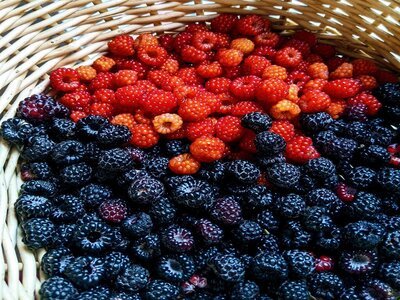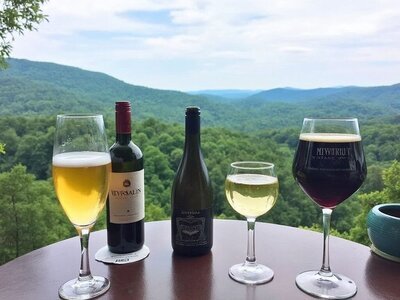Blog/Experiences
Wild Berry Bonanza: A Guide to Berry Seasons from May to August in Virginia’s Shenandoah Valley

This guide is based on foraging southern Shenandoah Valley, around Lexington and Natural Bridge, Virginia down through Roanoke, VA. Berry enthusiasts can enjoy a diverse array of wild and cultivated berries throughout the late spring and summer months in Shenandoah Valley. Here's a guide to the berry seasons in this region:
Spring Berries
Mulberries: These are typically the earliest berries to ripen, usually available from late May through early July. Red mulberry trees (Morus rubra) can often be found along backroads and in understory areas, especially near streams and old fencerows. Serviceberries (Juneberries): As their alternate name suggests, these berries typically ripen in June. They offer a sweet flavor with a hint of almond and are excellent for fresh eating or in pies and jams.
Early Summer Berries
Strawberries: While the peak season for strawberries in central Virginia is typically May, in the slightly cooler Shenandoah Valley region, you might find them available into early June. Raspberries: Black raspberries (Rubus occidentalis) usually ripen next, featuring purplish-black drupes that are sweeter than their blackberry relatives. Red raspberries may have a limited early harvest around mid-June, with a more substantial fall crop.


Mid-Summer Berries
Wineberries (Rubus phoenicolasius): These invasive but tasty berries typically ripen from late June to August. In the Shenandoah Valley, expect them to be ready for picking in early to mid-July. Blackberries (Rubus allegheniensis): The blackberry season usually runs from mid-July through August in this region. Dewberries (Rubus flagellaris): These close relatives of blackberries ripen around the same time. Elderberry (Sambucus nigra): This superfruit is widely enjoyed by wildlife and humans alike. Elderberries are not only delicious when cooked into jams, pies, and wines, but they also have impressive medicinal properties. The berries and flowers are rich in antioxidants, vitamins, and immune-boosting compounds, making them a valuable wild edible. In the Shenandoah Valley, elderberry season typically runs from mid-July through August. Ground-cherries (Physalis virginiana): These small, yellow-orange berries enclosed in papery husks have a sweet-tart flavor often compared to pineapple. They typically ripen in mid to late summer.
Late Summer Berries
Blueberries: While not as common in the wild in this area, highbush blueberries (Vaccinium corymbosum) are the last of the summer berries to ripen, typically available from late July into August. For foragers and berry enthusiasts in the Lexington and Natural Bridge area, this progression of berries offers opportunities from late spring through late summer. The specific timing can vary based on local microclimates, elevation, and yearly weather patterns. When foraging, always ensure proper identification of plants and be aware of local regulations regarding wild harvesting. For those who prefer cultivated berries, local farms and farmers' markets in the area often offer pick-your-own options or fresh-picked berries throughout the season. Remember that berry seasons can overlap, especially in years with unusual weather patterns. In some fortunate years, you might even find multiple berry species available simultaneously, allowing for delightful mixed berry harvests.


Where to Look for Berries
Look for berry bushes and trees in the following locations:
- Field edges and borders of woodlots
- Roadsides and old fencerows
- Streamsides and wetland areas
- Recently disturbed areas like clear cuts or burns
Some species like mulberries prefer the understory, while others thrive in full sun. Wineberries, blackberries and dewberries are often found together in mixed thickets.
Identifying Berries
When foraging for wild berries, it's absolutely critical to properly identify each species before consuming, as some can be poisonous. While many red, black, and purple berries may appear tempting, it's important to exercise extreme caution - up to half of red berries can be poisonous, and even 25% of black and purple berries may be unsafe. The only way to ensure your safety is to have any foraged berries positively identified by an expert botanist or experienced forager before eating. Never consume a berry unless you are 100% certain of its identification and edibility. When in doubt, leave it out. That said, here are some key identifying features to look for when attempting to recognize common wild berries in the Shenandoah Valley region:
Mulberries (Morus rubra):
- Heart-shaped leaves with rough texture and rounded teeth on edges
- Leaves are 3-5 inches long and 2-4 inches wide
- Berries start out white, turn pink, then ripen to a dark purple-black color
- Berries are 1-1.5 inches long, elongated and cylindrical in shape
- Grow in clusters on the branches
Serviceberries (Amelanchier arborea):
- Shrubs or small trees growing 15-25 feet tall
- Leaves are oval to elliptical, 1-3 inches long, finely toothed
- Produce clusters of small white flowers in early spring before leaves emerge
- Berries start out red, ripening to a dark purple-black color
- Berries are small, only 1/4 to 1/2 inch in diameter
Raspberries (Rubus occidentalis):
- Canes are covered in small thorns or prickles
- Leaves are compound with 3-5 leaflets, green above and silvery-white below
- Flowers have 5 white petals
- Berries are red, black, purple or yellow depending on variety
- Berries are composed of many drupelets surrounding a hollow core
Wineberries (Rubus phoenicolasius):
- Canes are covered in small reddish glandular hairs and small thorns
- Leaves have 3 leaflets, green above and silvery-white below
- Flowers have 5 white petals
- Berries are bright red in color
- Berries are composed of many drupelets surrounding a solid core


Blackberries (Rubus allegheniensis):
- Canes are covered in larger hooked thorns than wineberries
- Leaves have 3-5 leaflets, green on both sides
- Flowers have 5 white petals
- Berries are black when ripe
- Berries are composed of many drupelets surrounding a solid core
Blueberries (Vaccinium corymbosum):
- Shrubs growing 6-12 feet tall
- Leaves are elliptical, 1-2 inches long, blue-green in color
- Flowers are small, white to pinkish, bell-shaped
- Berries are dark blue with a whitish bloom
- Berries are 1/4 to 1/2 inch in diameter
Elderberries (Sambucus canadensis):
- Shrubs growing 5-12 feet tall
- Leaves are compound with 5-11 leaflets, each 2-6 inches long
- Flat-topped clusters of small white flowers in early summer
- Berries start out green, turn red, then purple-black when ripe
- Berries are small, only 1/4 inch in diameter but grow in large clusters
Ground-cherries (Physalis virginiana):
- Annual plants growing 1-3 feet tall
- Leaves are 2-4 inches long, oval to heart-shaped
- Flowers are small, yellow, bell-shaped
- Berries are enclosed in a papery husk that splits open when ripe
- Berries are 1/2 to 1 inch in diameter, yellow to purple when ripe




Enjoying Your Harvest
Once you've positively identified the berries and confirmed their edibility with an expert, you can safely enjoy them fresh or use them in jams, pies, cobblers, and other desserts. Many wild berries can be consumed raw or cooked, allowing you to experience different flavor profiles. Elderberries, however, are best cooked before eating. While the berries are packed with antioxidants, vitamins, and immune-boosting properties, they contain trace amounts of cyanide-inducing compounds that are deactivated through cooking. Remember to only pick from areas free of pesticides or other contaminants. Just select the ripest, sweetest berries and allow others - both humans and wildlife - to also benefit from the berry bounty and its antioxidant power boost. And always get permission before foraging on private property. With a little knowledge and care, you can safely and sustainably enjoy the delicious wild berries of the Shenandoah Valley. Much like eating local honey can help support your immune system, consuming antioxidant-dense local berries provide health benefits. Happy Foraging.












